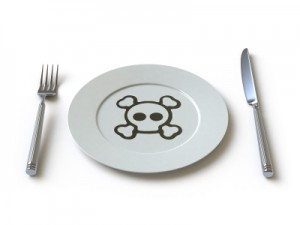 Foodborne outbreaks are scary and unfortunately more common than we think. There is nothing worse than not knowing if your next meal may land you a stay in the hospital.
Foodborne outbreaks are scary and unfortunately more common than we think. There is nothing worse than not knowing if your next meal may land you a stay in the hospital.
Campylobacter: Guillain-Barre syndrome (GBS)
E. coli 0157:H7: Hemolytic uremic syndrome (HUS), leading cause of kidney failure in children. If you are diagnosed with HUS, the long-term effects could include end-stage renal disease, diabetes and neurological disorders
Listeria: Infections of the brain and spinal cord, seizures and paralysis
Salmonella: Reactive arthritis (ReA)
Taxoplasma: Mild to severe mental retardation, visual impairment, blindness
Source: Report from the Food Safety Education Conference by the Center for Foodborne Illness Research & Prevention, Atlanta, Georgia, March 2010.
The culprits for toxic food outbreaks include everything from alfalfa sprouts to bologna and even, to the dismay of many, prepackaged cookie dough.
In most cases becoming ill from a foodborne pathogen might create mild discomfort until the offending bug exits your system. And then there are those well-publicized cases where a foodborne illness can turn severe and even deadly.
Recent morbidity and mortality reports provided by the Centers for Disease Control and Prevention state that of the 1,034 foodborne outbreaks in 2008, 23,152 people became ill, 1,276 were hospitalized, and 22 people died during the course of contaminated food outbreaks. Making food contamination a serious public safety issue.
Health insurance companies respond to contaminated food outbreaks in the same manor that they would a serious flu outbreak.
“Insurance companies have contingency plans in place for assorted emergencies – such as natural disasters, pandemics, etc. Obviously, the plans are tailored to the specific need presented by whatever has gone wrong,” explains Scot Roskelley, spokesperson for the group health insurance division of Aetna. “There are plans in place for if large number of employees become ill (and how to continue providing service to our members), as well as if large numbers of our members become ill and are placing claims. ”
 It is estimated that foodborne illnesses in the United States cost Americans $152 billion a year in healthcare, workplace productivity, death and disability, according to a March 2010 Georgetown University study written by Robert L. Scharff, a former economist with the Food and Drug Administration and assistant professor at Ohio State University. An estimate that would contribute to the rise in health care costs and in turn, the amount consumers pay for health insurance.
It is estimated that foodborne illnesses in the United States cost Americans $152 billion a year in healthcare, workplace productivity, death and disability, according to a March 2010 Georgetown University study written by Robert L. Scharff, a former economist with the Food and Drug Administration and assistant professor at Ohio State University. An estimate that would contribute to the rise in health care costs and in turn, the amount consumers pay for health insurance.
“If there were a large-scale foodborne epidemic, our members’ plans would cover them no differently than they would for any other major medical necessities, ” says Roskelley.
Health insurers have emergency preparedness plans in place to tackle any foodborne illness emergency. The majority of medical care cost-prevention falls squarely on the shoulders of government to work with agriculture and retail industries to provide regulatory means to food manufacturers in order to prevent the possibility of a foodborne illness outbreak, explains Susan Pisano, spokesperson for America’s Health Insurance Plans (AHIP).












